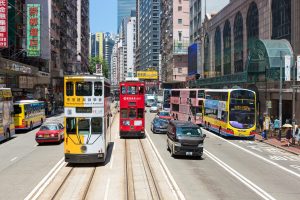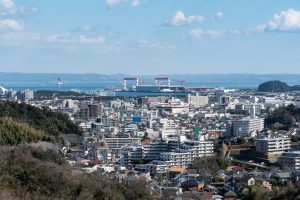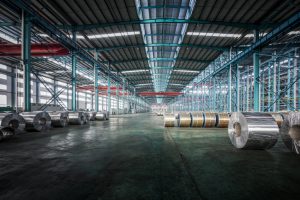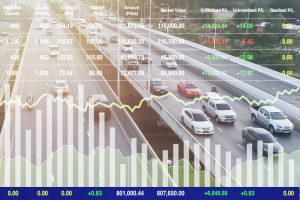Introduction
The ReVision Mobility Summit, an event that we support as a Platinum Sponsor, was held at Belle Salle Onarimon Tower on March 10 and 11.
At this 5th Summit event, 21 presentations were held under the theme of “Reassessing the Evolution of CASE from New Perspectives” on the first day and “Exploring the Potential for MaaS in Smart Cities, Local Regions, and Logistics.” At our company’s invitation, Mr. Miyazaki of the Automotive Engineering business of Sumitomo Corporation delivered a lecture titled “The Business Vision for ‘Beyond Mobility’ Business that Evolves Mobility” on the second day.
Also at this event, Mr. Furukawa, an automobile industry leader with our partner ABeam Consulting, presented a lecture titled “Automobile and Mobility Industry Transformations Taking Place in the Post-Corona Era.” This article will introduce the content of the lecture.
ABeam Consulting is a Japan-based comprehensive consulting firm active in areas spanning strategy planning/conceptual formulation to business transformation/design and system development/implementation. In the automobile industry, the company provides support for automobile manufacturers and parts suppliers in Japan, through strategy, research, system implementation, and other services. Addressing the mobility service area, Mr. Furukawa’s lecture analyzed changes in the lifestyles and behaviors of people and in the business environment under the COVID-19 pandemic, along with the evolution of operations through MaaS and vehicles, and profit improvement measures employing artificial intelligence (AI). The content combined concrete examples to introduce approaches and technologies needed by the automobile and mobility industries.
Changes in patterns of behavior
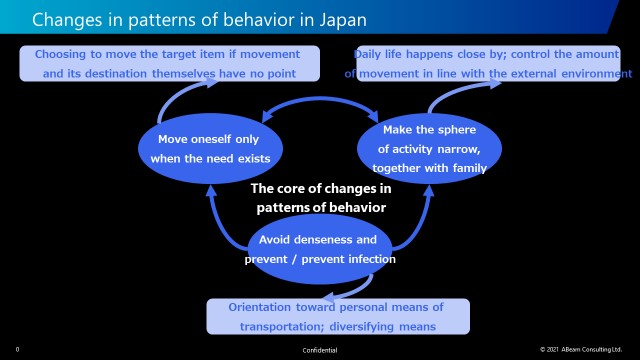
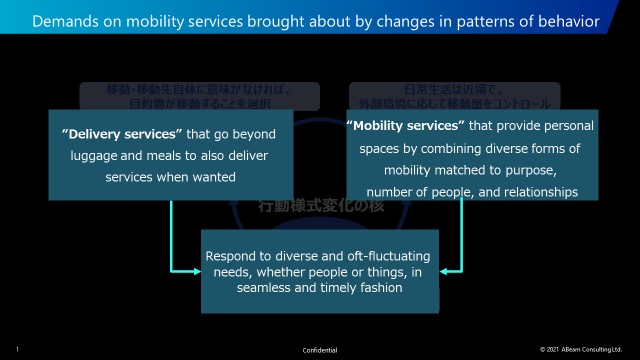
In Japan, a mindset of avoiding closeness to keep from getting or spreading contagion has taken root, raising a new awareness of the question “why move?” This has brought about a paradigm shift in patterns of behavior regarding movement. In short, people are choosing to move only when necessary; the pattern of behavior has changed to one of not moving when the movement itself has no point, and of keeping the sphere of activity narrow together with family.
Under such changes in mindset and patterns of behavior, what is sought from mobility services will also change. Services that deliver not only luggage, meals and other services when it is needed. To make decisions on whether or not to move in accordance with the outside environment, while also seeking personalization, mobility services that provide personal spaces by combining diverse forms of mobility matched to purpose, number of people, and social relationships will be demanded.
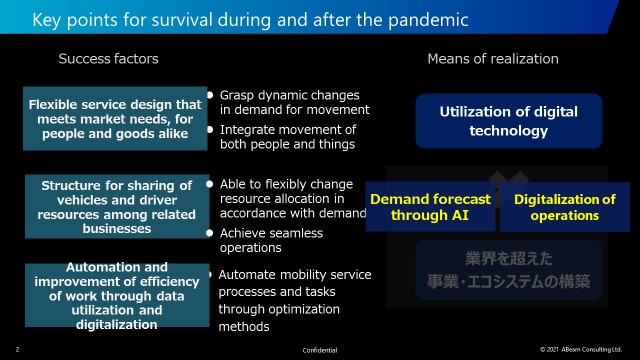
The following are noted as three success factors for responding to such changes in patterns of behavior.
- Flexible service design, for people and things alike
- Creation of systems for sharing vehicle and driver resources
- Business automation and improvement of efficiency through digitalization
In service design, there will be a need for responses such as integrating the movement of both people and things while grasping dynamic changes in movement demand. In the sharing of vehicle and driver resources, too, there will be a need to flexibly change resource allocation according to demand, and to further execute seamless operations. Moreover, in automation and improvement of efficiency, there will be a need to optimize and automate all processes and tasks in mobility businesses. Amid these circumstances, the importance of digital technology continues to grow.
Understanding the dynamic needs of the market is important in achieving flexible mobility services, but these dynamic needs are influenced by policy measures, pandemic conditions, and economic conditions. As it is difficult to capture and respond to market changes through manual tasks and other conventional means in an environment of large market changes, utilizing digital technologies to create businesses and ecosystems that transcend industries will be a factor for success.
As an example, AI and machine learning-based demand forecasting technology can be harnessed to enable the forecasting of dynamic demand. In flexible resource allocation, too, while it is practically impossible to manually allocate both human and vehicle resources to meet rapidly changing demand, digitalizing operations enables automation of many processes and tasks in optimal ways.
Following this are examples of the use of such digital technology.
Social issues and mobility services in Phnom Penh
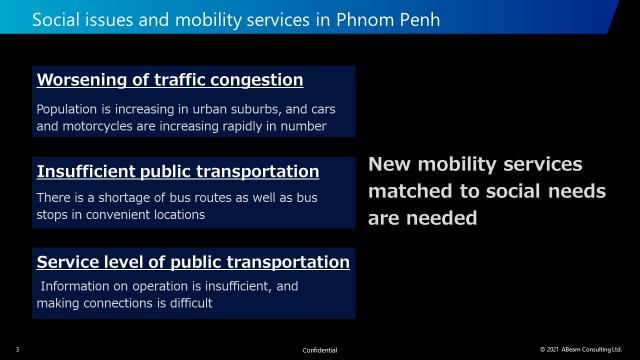
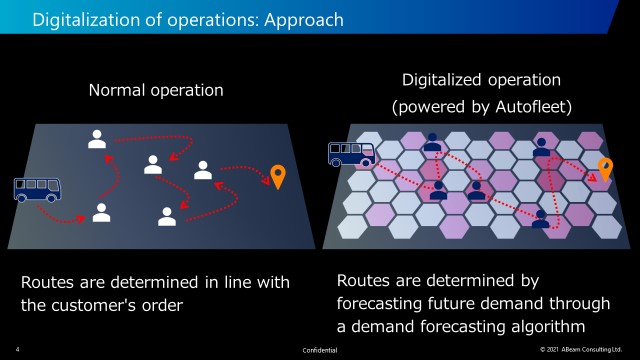
Population has increased in areas surrounding Phnom Penh, and automobiles and motorcycles have increased rapidly. Traffic congestion has severely worsened, and public transportation is lacking. The state of bus route operation in particular is faced with stops in inconvenient locations, little service-related information, and difficulty in making connections. The result has been a need for new mobility services to solve these social issues. ABeam Consulting is providing support for strategic planning and business simulation aimed at the introduction of on-demand bus services for riders commuting from the suburbs to the city center. The company set three KPIs for investigating the business: number of passengers, waiting time, and boarding efficiency. In considering the optimization of these three conflicting KPIs, ABeam used the business simulator of its technology partner Autofleet.
In setting operating routes, Abeam investigated mechanisms to predict and determine future demand from past data on movement. Using forecasts made this way, buses select the routes for which the greatest demand has been predicted. Passing through the routes, they pick up passengers based on actually emerging demand and transport the passengers to their destinations. This enables operation that can efficiently transport a large
number of passengers, without having to wait for those passengers.
In a trial calculation of this digitalized operation, occupancy rate improved 30% and driving time declined by 25% compared to normal operation, confirming high efficiency. In addition, as Autofleet’s simulator is able to forecast demand by time slot, it is possible to consider further improvements in efficiency, such as putting vehicles to use in other mobility services during low-demand time slots.
In closing
Wrapping up the lecture, Mr. Furukawa noted, “It is very difficult to create a sustainable business with only one mobility service.” It is believed that two factors are important for success. First, the development of multiple demand forecasting algorithms such as those mentioned in the examples. Second, mobility services incorporate varied information through collaboration among industries. Especially considering the magnitude of the changes in the market, businesses must not only ask what they can do but also ask what the market is demanding, then leverage digital technology to solidly predict demand and offer flexible mobility services in response. This is surely what will lead to the provision of mobility services from consumers’ point of view, and in turn to the resolution of social issues.
Sources:
■ ABeam Consulting, Ltd., 5th ReVision Mobility Summit Lecture Materials, “Automobile and Mobility Industry Transformations Taking Place in the Post-Corona Era”(Japanese only)



